Magnificent, awesome, stunning, exquisite, beautiful bird. I could use an entire thesaurus of superlatives for this Barking Owl and still not do it justice – I think I’m in love.
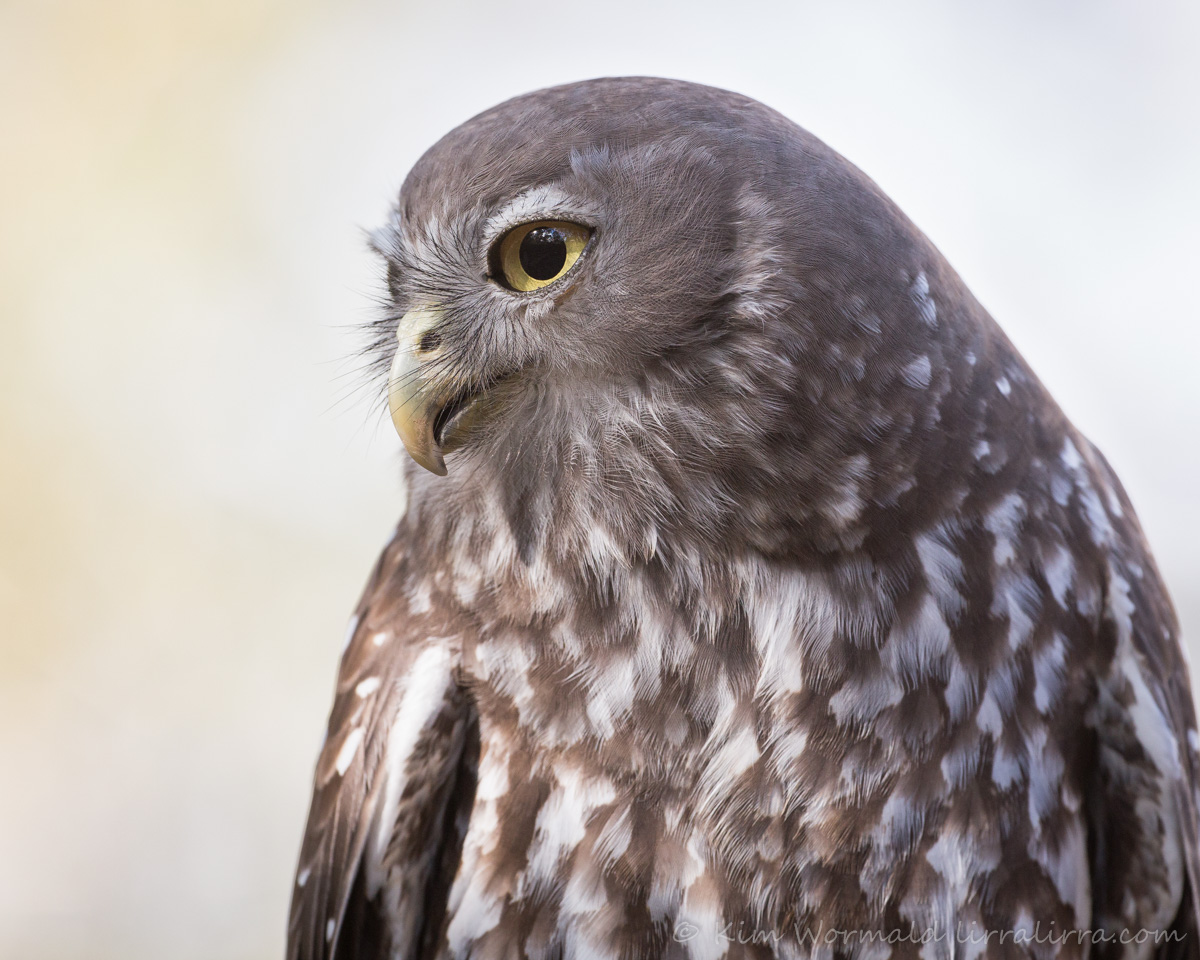 Barking Owl (Ninon connivens)
Barking Owl (Ninon connivens)
Canon 5DIII, f/6.3, 1/400, ISO 800, focal length 400mm
Recently I have visited Healesville Sanctuary so often that they may start charging me rent. As I choose not to use a flash when photographing birds virtually my only opportunity to shoot nocturnal species is to visit places that rehabilitate injured birds or raise them for species research and public education. I watched the Birds in Flight show several times during the recent school holidays and there was standing room only each time. That is a lot of children being awed by nature and that makes me smile.
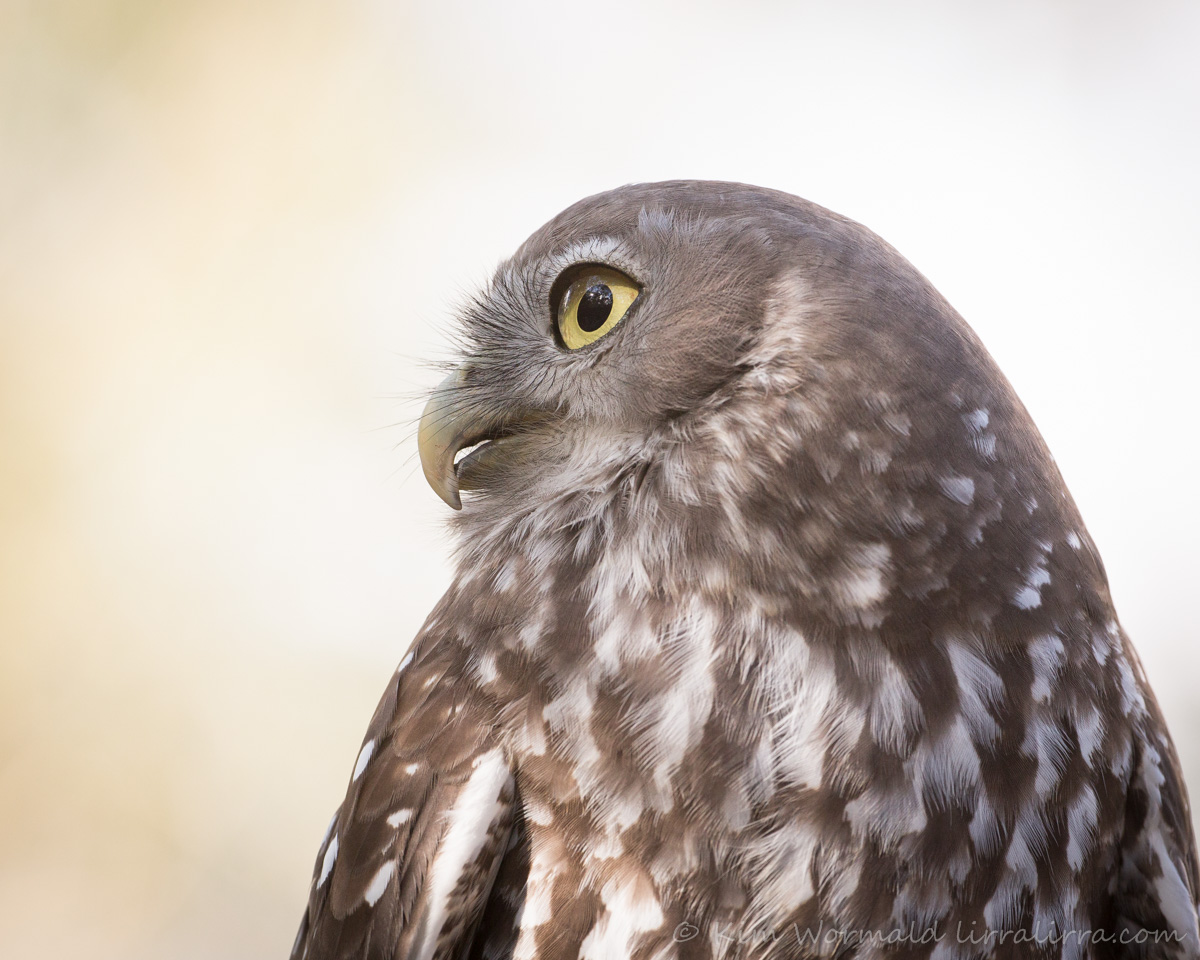 Barking Owl (Ninon connivens)
Barking Owl (Ninon connivens)
Canon 5DIII, f/7.1, 1/400, ISO 800, focal length 400mm
This week’s series of portraits show a range of details about Barking Owls that caused me to be awed by nature too. Barking Owls are from the hawk-owl family so they don’t have the heart-shaped ruff of Barn Owls and other owls from the tyto family. The profile image above shows the erectile throat feathers beneath the strong curved bill. Across and above the bill are spiky feathers that help guide insect prey into the owl’s mouth, this is easier to visualise if you imagine the owl has its bill wide open. Barking Owls take all kinds of prey and are known to hunt earlier in the evenings and later in the mornings than other owls. As well as insects they take a wide variety of birds including species as large as magpies, kookaburras and cockatoos. They also take mammals including possums, gliders, bats and rodents but overall their main prey across much of south-eastern Australia is believed to be rabbits.
 Barking Owl (Ninon connivens)
Barking Owl (Ninon connivens)
Canon 5DIII, f/5.6, 1/400, ISO 400, focal length 400mm
Raptors have incredibly intense stares, just the sight of a face like the one above would be enough to terrify prey. For a few years, a long time ago, I had a small wildlife shelter in the foothills of the Dandenong Ranges east of Melbourne. One of the babies I raised was an Australian Magpie that had been handed in when it was just a day or so out of the egg. I wasn’t sure whether it would survive but with strips of beef heart dipped in calcium powder among other items in its diet it did extremely well. It soon progressed from a cage in the laundry to a large aviary in the back garden where a remarkable thing happened when local magpies occasionally fed it through the bars. If they’d visited more often I would have released it with them but protocol dictated that it should be released where it had been found. One day I heard the poor bird sounding distressed and I raced outside to see a Little Eagle clinging to the side of the aviary and peering at the young magpie with a look similar to that in the image above. It’s fascinating to think of the power of instinct that enabled the magpie to recognise the eagle as a threat despite being hand-reared.
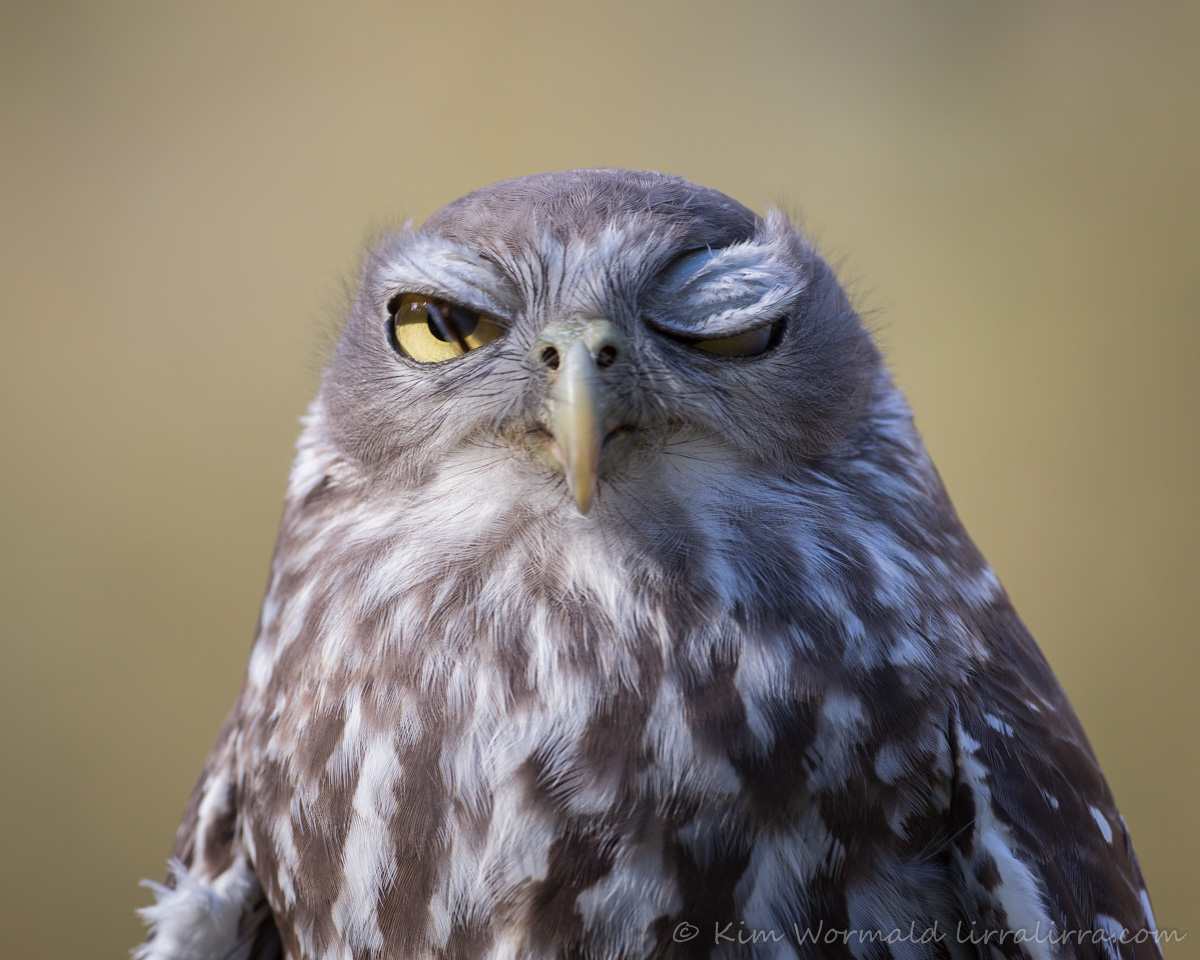 Barking Owl (Ninon connivens) – Winking Owl, normal eyelid and nictitating membrane
Barking Owl (Ninon connivens) – Winking Owl, normal eyelid and nictitating membrane
Canon 5DIII, f/5.6, 1/400, ISO 400, focal length 400mm
Barking Owls are also known as Winking Owls so she was named Millibai which means ‘winking’ in an Aboriginal language. Millibai, or Millie for short, was bred in captivity at Featherdale Wildlife Park in NSW and sent to Healesville Sanctuary to be hand-reared when she was just 4 weeks old. The image above isn’t at all flattering but it does show her winking with her beautifully feathered eyelid (which I couldn’t resist sharing). Less attractive, but vitally important, is the nictitating membrane that is partially across her other eye. These membranes clean and lubricate her eyes and provide protection from harsh light and strong wind. They are talked about briefly in an earlier post: Pelicans with patterned pouches
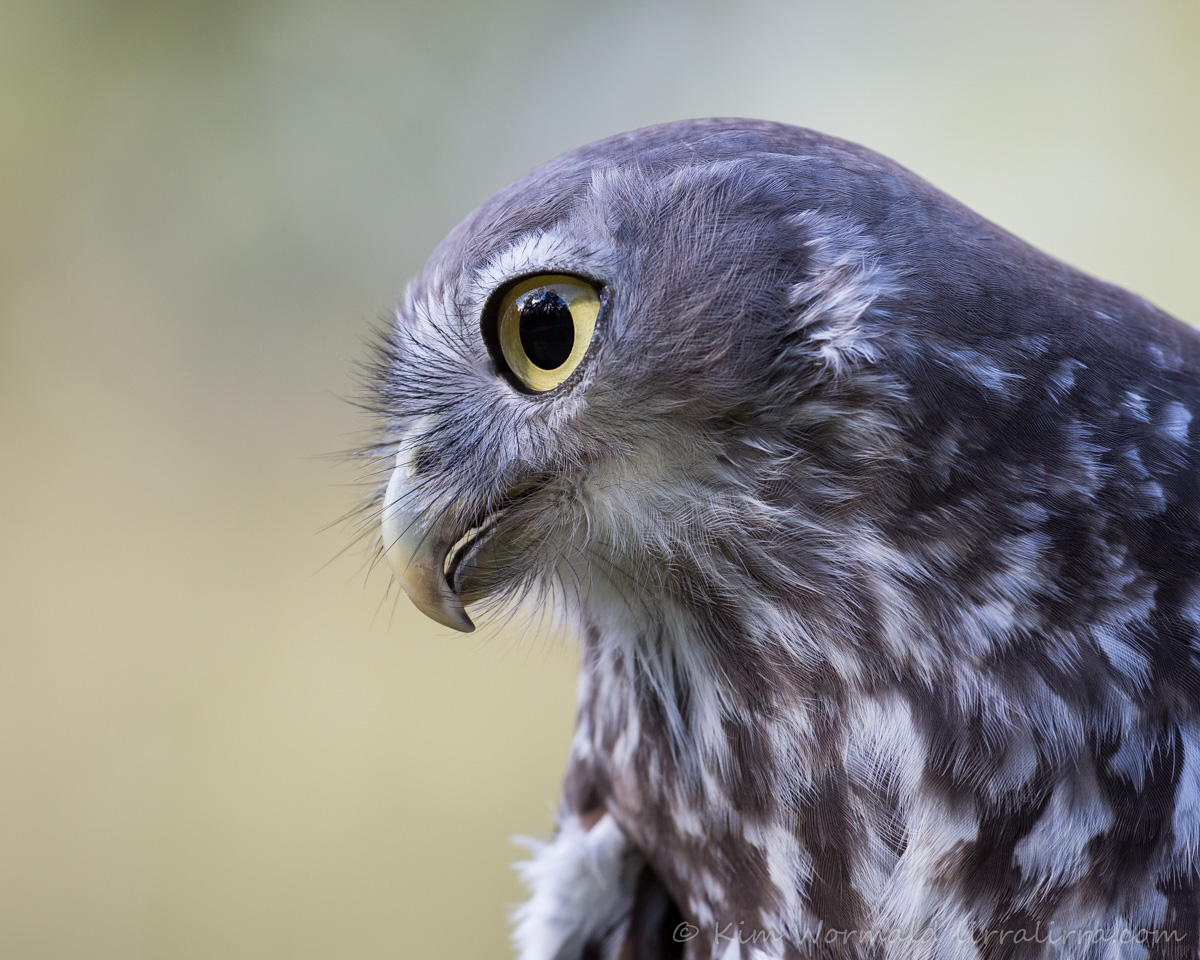 Barking Owl (Ninon connivens)
Barking Owl (Ninon connivens)
Canon 5DIII, f/5.6, 1/400, ISO 800, focal length 400mm
The image above highlights the bristles around Millie’s bill, her erectile throat feathers and her steely stare. Barking Owls have massive yellow eyes and I was fascinated to see that they are hooded by the eyelids. The image above, along with several of the others, shows how her upper and lower eyelids protrude, somewhat like a peaked cap, to protect her eyes. The upper ‘hood’ often casts a curved shadow on her eye. I have noticed the same feature in Tawny Frogmouths but am not sure if it is typical of nocturnal hunters.
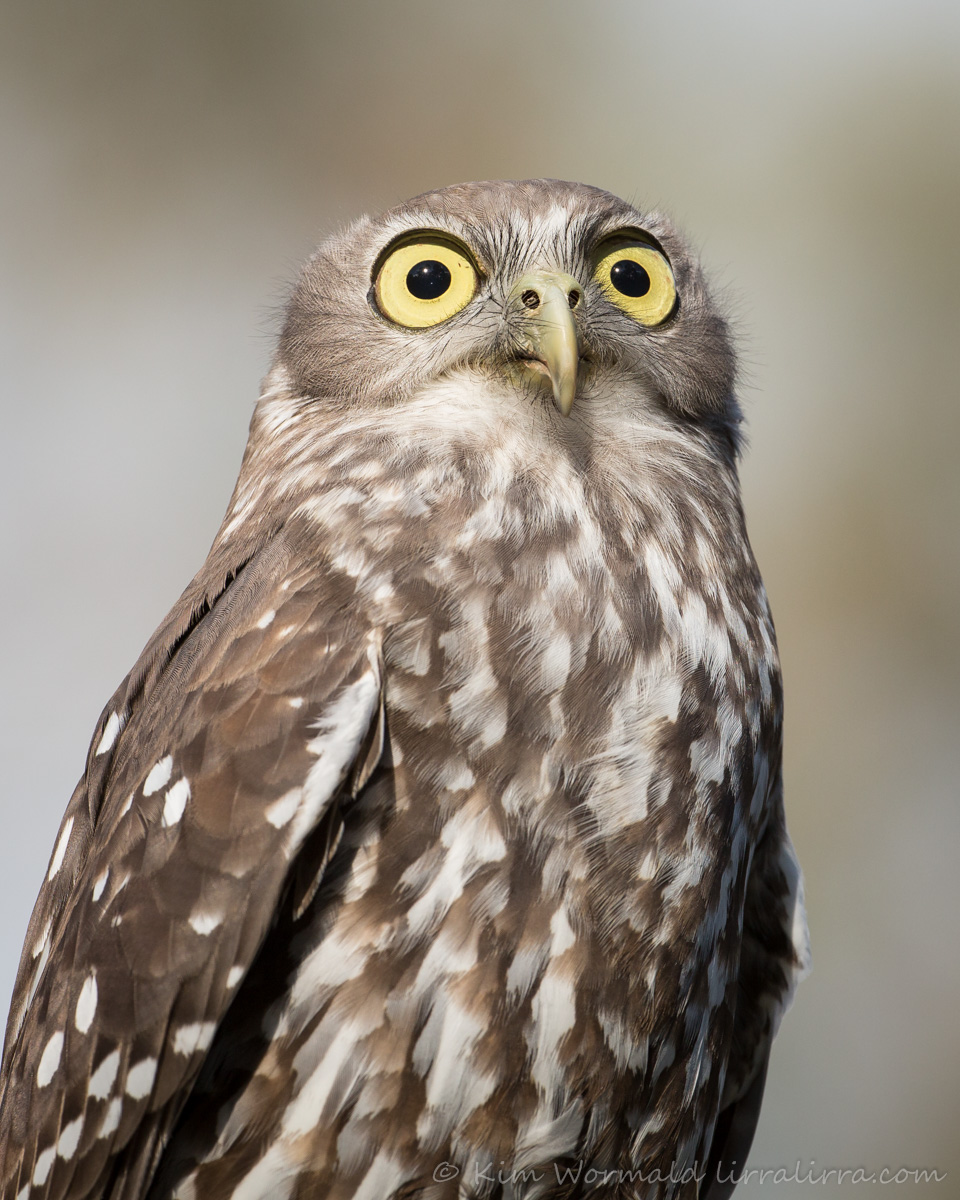 Barking Owl (Ninon connivens)
Barking Owl (Ninon connivens)
Canon 5DIII, f/7.1, 1/800, ISO 400, focal length 400mm
Although Barking Owls are aggressive predators they are themselves vulnerable to attack and Millie was constantly on guard to make sure that she knew what was happening around her, include what was flying above her. Her ‘peaked cap’ eyelids can be clearly seen in the image above.
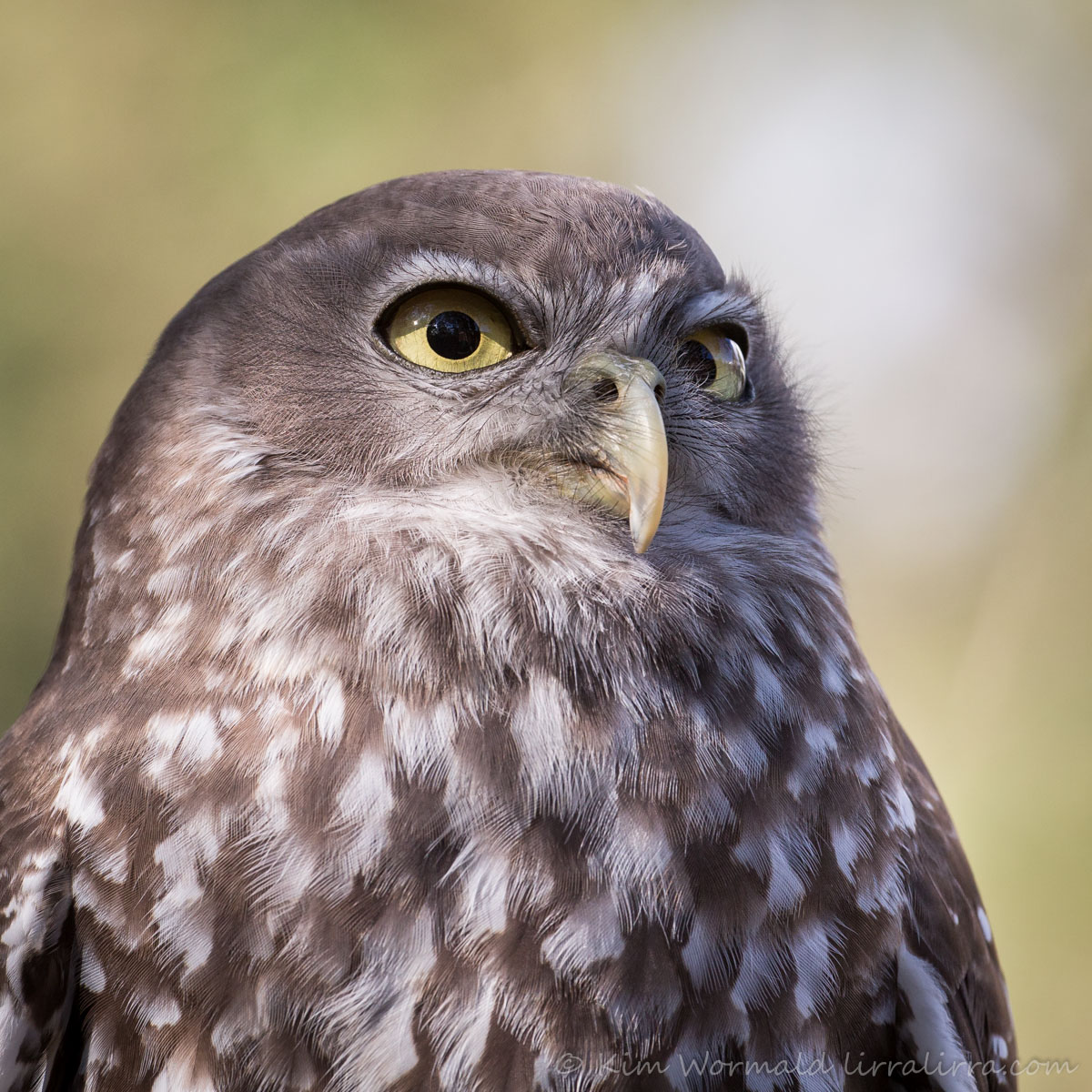 Barking Owl (Ninon connivens)
Barking Owl (Ninon connivens)
Canon 5DIII, f/7.1, 1/400, ISO 800, focal length 400mm
Barking Owl’s eye are so large that the doomed front is clear and is transparent on side view. None of my images show this clearly but it can just be seen in Millie’s left eye, above.
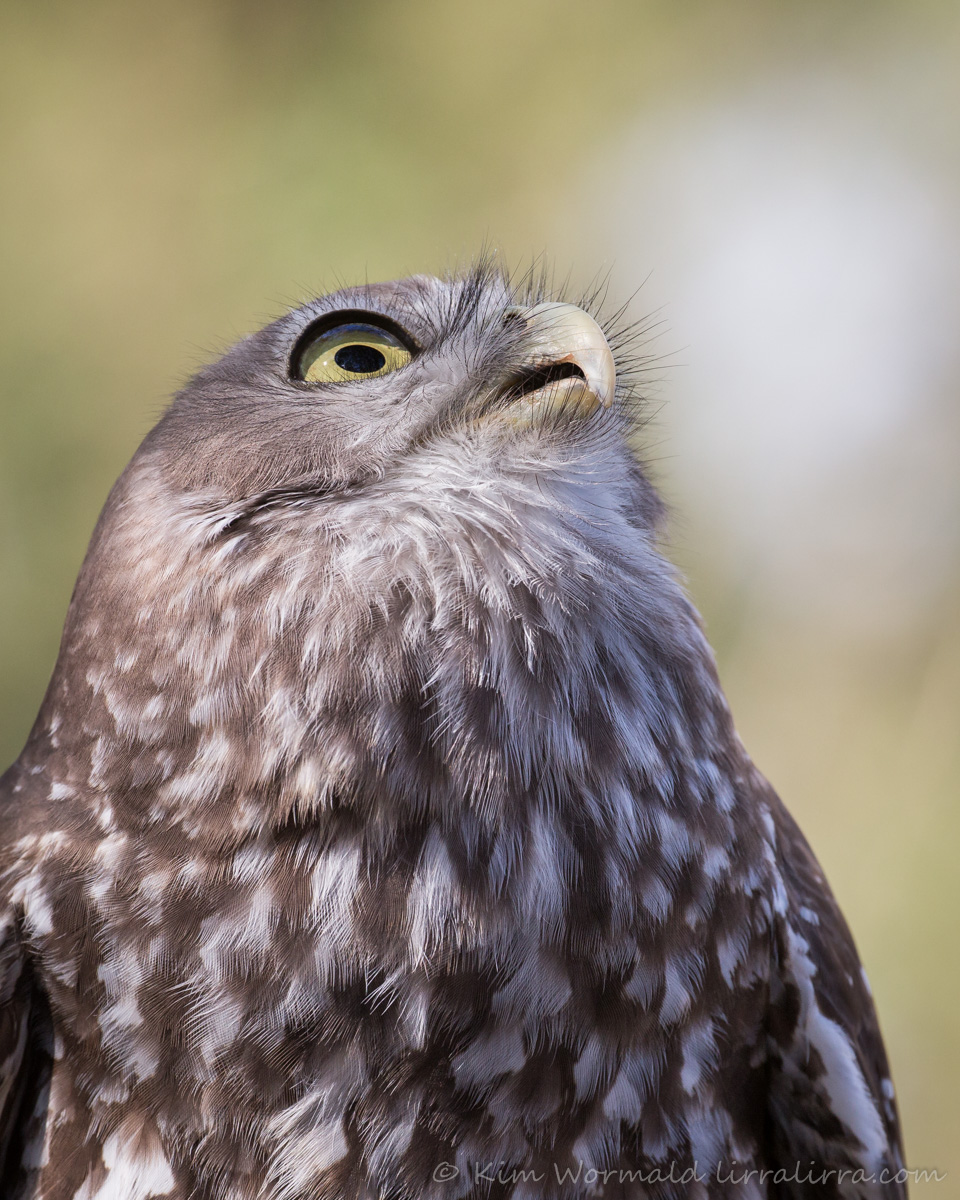 Barking Owl (Ninon connivens)
Barking Owl (Ninon connivens)
Canon 5DIII, f/7.1, 1/400, ISO 800, focal length 400mm
The image above shows several of the features already mentioned, especially keeping an eye on the sky. Photographers may have noticed that my camera settings have been set from f/5.6-7.1 while the ISO has been either 400 or 800. Lighting conditions often change when shooting outside. Partial cloud cover means that the available lighting can change just as you’re about to press the shutter button. This is complicated further as the bird itself can be in sun or shade. I try to keep my ISO as low as possible and in some of this week’s images that meant I needed to open the aperture to f/5.6 with a resulting impact on the depth of field. The relatively low shutter speed of 1/400 sec meant that many shots were unusable as birds move rapidly and constantly even when they are not in flight.
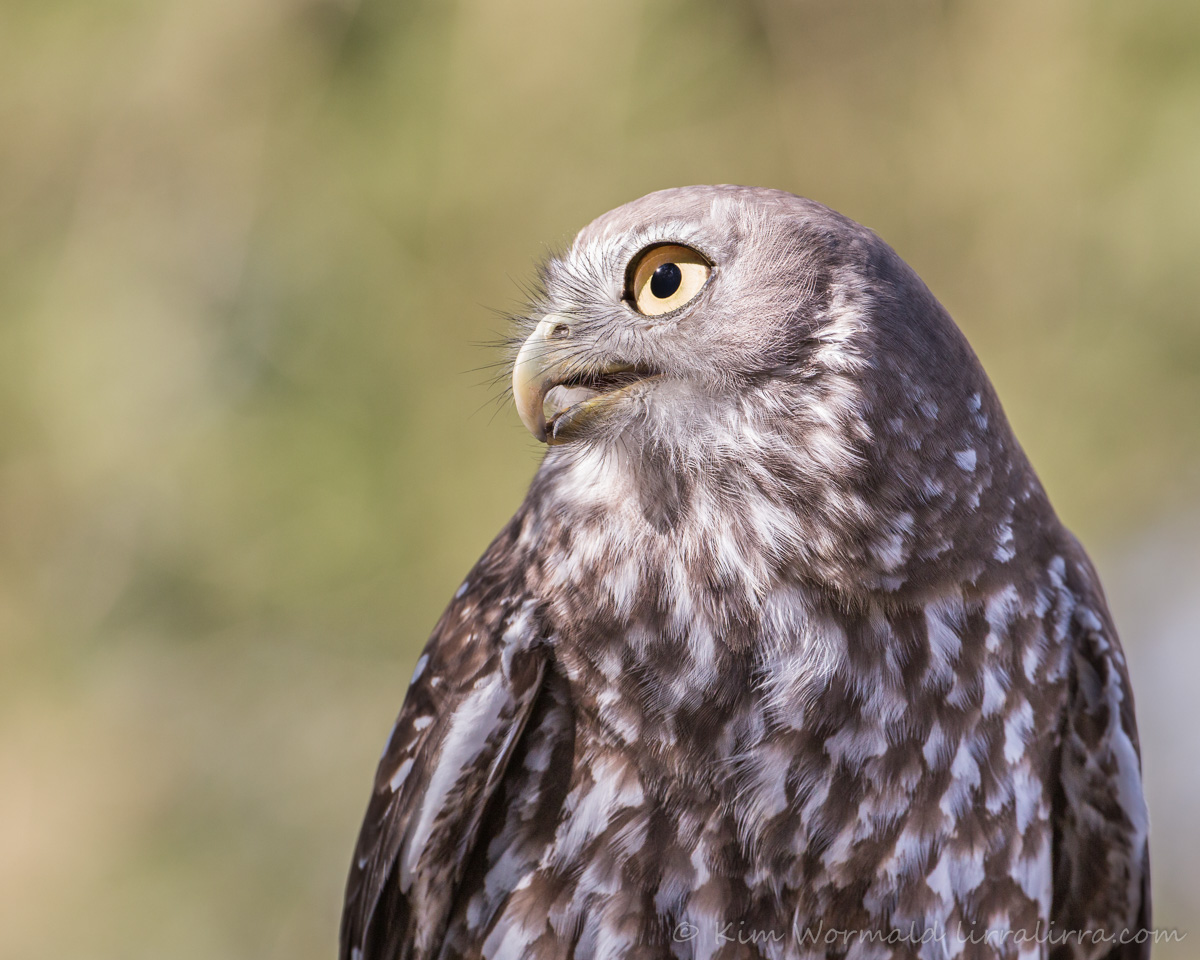 Barking Owl (Ninon connivens)
Barking Owl (Ninon connivens)
Canon 5DIII, f/6.3, 1/400, ISO 400, focal length 400mm
I particularly like the background bokeh in this image. It also shows Millie’s dark brown, tan and white feathers.
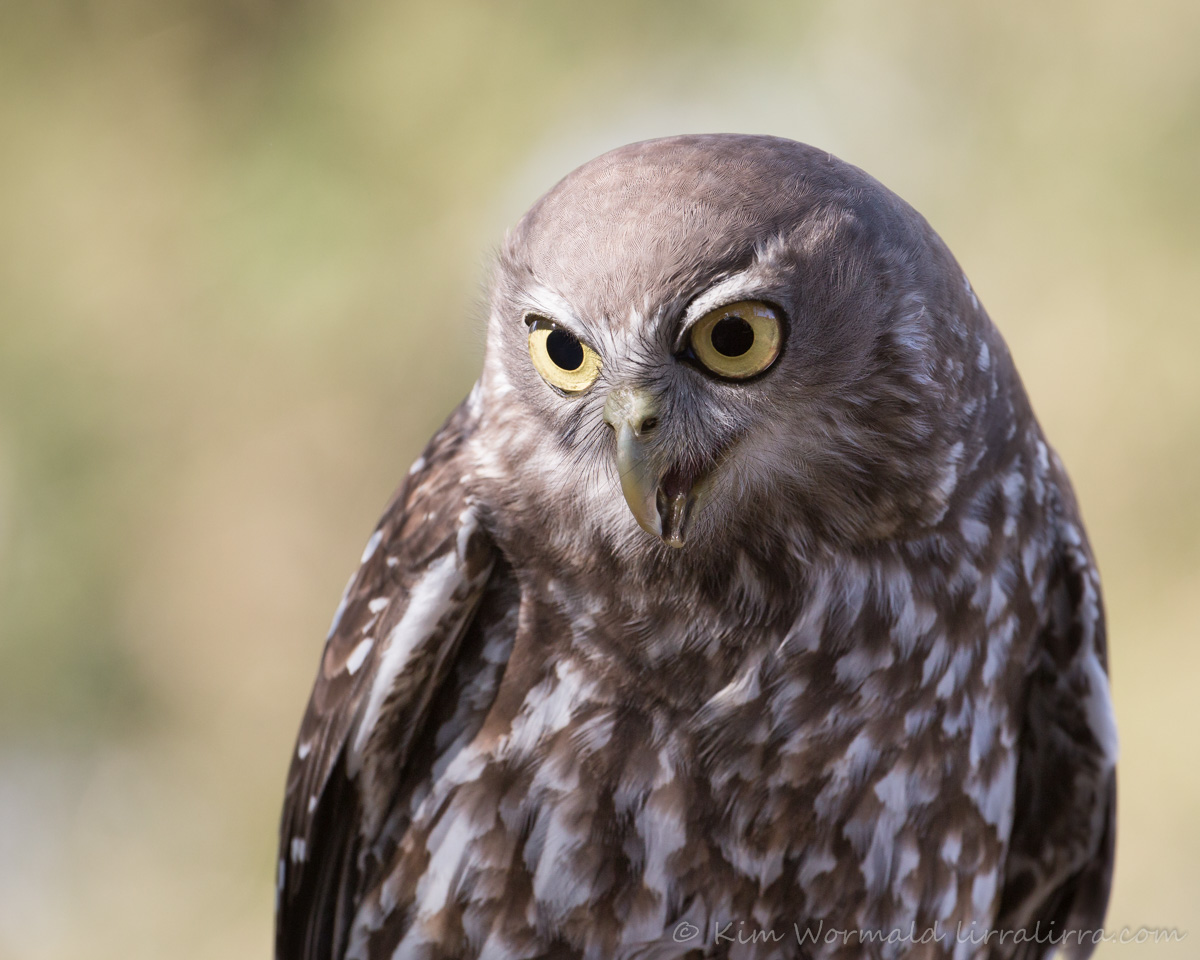 Barking Owl (Ninon connivens)
Barking Owl (Ninon connivens)
Canon 5DIII, f/5.6, 1/400, ISO 400, focal length 400mm
((( shivers ))) Can you imagine being small enough for this owl to think of you as lunch?
The call of the Barking Owl is easy to guess, they really do sound like dogs. I was also aware of their ‘screaming woman’ call but never before had I heard the soft warbling kind of purr that made them sound more like a Little Penguin than an owl.
Images of a Barking Owl in flight can be seen in an earlier lirralira post at Barking Owl Test Shots
Special thanks to Jason for his help with this post and for answering many questions.
Happy birding, Kim
~ Thank you for visiting and commenting
~ If you would like a weekly email letting you know that lirralirra has been updated please use the ‘subscribe’ box above right

As always STUNNING images and so much information! What a cool bird and I had to chuckle at the wink – you have to be one of very few that got that shot! Now I have to go find the sounds it makes…..
I’m glad you enjoyed the images and the wink! I hope you managed to hear it’s call. If not, the ‘barking’ call can be heard on this link: http://www.birdsinbackyards.net/species/Ninox-connivens
Fabulous photos Kim–your usual standard. Feathered eyelids! I never knew.
Me neither John!
Hi Kim, I am about to join the rest of your admirers, so hard to express my amazement in these photo’s, Her eye’s like you say do honestly give one the shivers, beautiful detail in the capture of the feathers. I have so enjoyed this sequence of images. Thanks Love Dona
Aw thank you Dona, I’m so pleased you enjoyed the images
Such a spectacular face! I love all the expressions and movements covered in this post. They eyelids are amazing! I am totally fascinated!
That’s just the way I felt Alyssa!
Hi Kim,
A large collection of beauties ! It’s a dream for me…
Good week end and thank you.
Thank you for your comment Alain, and you have a good weekend too
PS I’ve enjoyed looking at your eklablog images Alain, beautiful images
I’m always worried about one of these fellas making off with my small dog this post has done nothing to quench those fears! Great photos though!
Your massive dog and your middle-sized dog would be okay but the furry mouse could be in trouble.
Wow. Gob and smacked. Awe and struck.
And jealous. So very, very jealous.
Thank you for sharing the magic.
You are so welcome EC
I am seriously short of superlatives or I would try to add some to your list for this terrific sequence of images showing many interesting features of the head and throat feather arrangement of the Barking Owl.
Dave, seeing the exquisite details of birds is one of my very favourite things about bird photography, I’m glad you enjoyed them too.
Wow, awesome photos.
Thank you Vicki, I’m glad you like them.